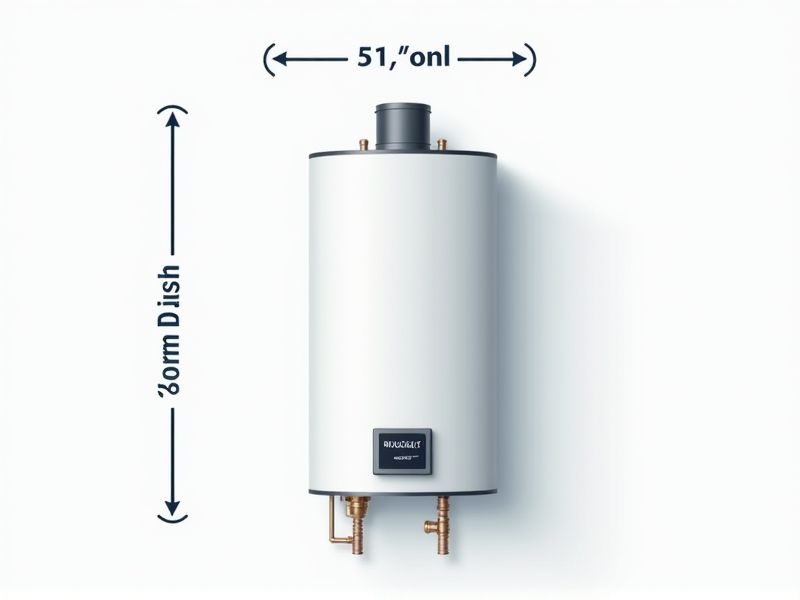
When choosing a water heater, it's helpful to know the standard dimensions to ensure it will fit your available space. Most residential tank-style water heaters typically range from 40 to 60 inches tall and 18 to 24 inches in diameter, depending on their capacity (usually 30 to 80 gallons). Tankless water heaters, which are more compact, often measure about 20 inches high, 14 inches wide, and 6 inches deep, making them suitable for smaller spaces. Always check the manufacturer's specifications for exact measurements before purchasing, as models and sizes can vary.
Capacity Measurement
When selecting a water heater, focus on capacity measurement, which is often indicated in gallons. Common residential water heater capacities range from 30 to 80 gallons, with a typical household benefiting from a 40 to 50-gallon unit. The first-hour rating (FHR) is a crucial metric--you should look for a water heater that can deliver enough hot water to meet your peak demand, which is usually during morning routines. Ensuring the right capacity prevents running out of hot water and optimizes energy efficiency, keeping your utility costs in check.
Diameter Specifications
The standard diameter specifications for residential water heaters typically range from 18 to 30 inches, depending on the model and capacity. For example, a standard 40-gallon tank generally has a diameter of about 20 inches, while a 50-gallon tank may measure 24 inches in diameter. These dimensions are crucial for ensuring proper fit and installation within your home's designated space, especially when considering accessibility for maintenance. Understanding these specifications can help you choose the right water heater that meets both your space requirements and hot water needs efficiently.
Height Considerations
When choosing a water heater, the height is a crucial factor that can affect installation and performance. Most residential water heaters range from 30 to 60 inches in height, with standard models typically standing around 48 inches. Ensure your installation area has at least 12 inches of clearance above the unit for proper ventilation and maintenance access. Proper alignment with local building codes is essential, as some jurisdictions may have specific height requirements for safety and efficiency.
Space Efficiency
Modern water heaters prioritize space efficiency, with compact models such as tankless and hybrid options designed to fit seamlessly into smaller areas. For instance, a tankless water heater can be as small as 20 inches high and 14 inches wide, providing hot water on demand without the bulk of traditional tanks. This innovation not only maximizes your available space but also reduces energy costs by eliminating standby heat loss, potentially saving you up to 30% on energy bills annually. When selecting a water heater, consider its dimensions, energy efficiency ratings, and flow rates to ensure it meets your specific needs without overwhelming your space.
Water Volume Ratings
When selecting a water heater, you should pay attention to the water volume rating, which typically ranges from 20 to 80 gallons. This rating determines how much hot water the unit can deliver during peak usage times. For households with multiple users, a capacity of 40 to 50 gallons is often optimal, ensuring sufficient supply for typical activities such as showers and dishwashing. By understanding these ratings, you can choose a water heater that meets your household's specific hot water needs efficiently.
Installation Requirements
Installation requirements for water heaters vary depending on the type, with tankless models typically needing less space compared to traditional tank systems, which can be bulky. Ensure the water heater's capacity meets your household demand; for example, a 50-gallon tank serves an average family of four efficiently. Venting requirements are crucial, as gas models require proper ventilation to prevent hazardous fumes, while electric units need adequate clearance around the unit for airflow. You should also consider local building codes, which may stipulate specific installation standards or permit requirements.
Shape Variations
Water heaters exhibit a variety of shape variations, including tankless models, traditional cylindrical tanks, and rectangular units. Standard capacities range from 20 to 80 gallons, with tankless versions providing endless hot water by heating on demand. Innovations in design not only enhance space efficiency but also improve energy performance, with some models boasting up to 98% efficiency ratings. By selecting the right shape and size for your home, you can optimize energy consumption and ensure adequate hot water supply for your needs.
Clearance Needs
When selecting a water heater, understanding clearance requirements is crucial for optimal installation and safety. Most manufacturers recommend a minimum clearance of 12 inches from combustible surfaces and at least 6 inches from walls to allow for proper airflow and maintenance. For gas water heaters, ensure a minimum distance of 18 inches from any furnace or appliance to reduce the risk of fire hazards. Failure to adhere to these clearance guidelines can lead to inefficient operation and void warranties, ultimately affecting your long-term energy costs and safety.
Weight Constraints
When selecting a water heater, consider weight constraints, as models can vary significantly; for instance, electric water heaters typically weigh between 100 to 150 pounds, while gas models can range from 150 to 300 pounds. Your installation location must support the unit's weight, ensuring structural integrity, especially in basements or upper floors. Moreover, excessive weight may necessitate additional reinforcement or a different heating solution, limiting your options. Always check the manufacturer's specifications and guidelines for the specific weight and installation requirements of any unit you are considering.
Support Structures
Support structures for water heaters are crucial for ensuring safety and longevity, typically requiring a minimum load capacity of 2,000 pounds. These structures often utilize materials like steel or reinforced concrete to withstand temperature fluctuations and prevent structural failure. When installing a water heater, it's essential that you follow local building codes, which may dictate specific design parameters, including height and stability. Regular inspections and maintenance of your support system can enhance performance and mitigate risks related to corrosion or deterioration.
